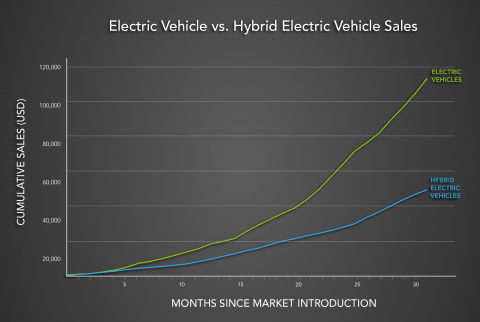Plug-in electric vehicle (PEV) sales tripled from about 17,000 in 2011 to about 52,000 in 2012. During the first six months of 2013, Americans bought over 40,000 plug-in electric vehicles (PEV), more than twice as many sold during the same period in 2012.
The latest numbers also show how the early years of the PEV market have seen much faster growth than the early years of the hybrid vehicle market. Thirty months after the first hybrid was introduced, monthly sales figures were under 3,000.
By comparison, PEVs – which were first introduced in December 2010 – report nearly 9,000 cars sold in the last month. At the same time, thanks to technology improvements and growing domestic manufacturing capacity, the cost of a battery has come down by nearly 50 percent in the last four years, and is expected to drop to $10,000 by 2015.
The Energy Department’s Argonne National Laboratory provides regular updates on monthly sales reported by automakers. Because Tesla Motors has not yet reported its second quarter sales figures, the site uses independent market estimates from the Hybrid Market Dashboard as a placeholder until the final sales numbers come in from the company.
The latest national eGallon price is $1.18, as compared to $3.49 for a gallon of unleaded gasoline. In June, the Department of Energy launched the eGallon to help inform EV drivers how much they can save by fueling their cars with electricity instead of gasoline. Our popular eGallon tool allows consumers to see the difference in eGallon and gasoline prices state by state.
This update comes as Energy Secretary Ernest Moniz today highlighted the continued growth of electric vehicle sales — doubling in the first six months of 2013 compared to the same period in 2012. In fact, according to numbers from Argonne National Lab and the Hybrid Market Dashboard, June’s EV sales were the strongest on record for the United States.
eGallon holds steady
First, the eGallon. What do EV drivers like to see from their eGallon? Low and stable prices. In the latest monthly data, which reflect April’s electricity prices, the national eGallon price rose about 4 cents — from $1.14 to $1.18. This slight increase in eGallon prices was predictable, as electricity rates generally trend upward as the hotter summer months approach — but, then again, so do gasoline prices. Even with higher summer electricity rates, the eGallon still costs about a third as much as a gallon of gasoline — and if you live in a state that offers reduced-rate prices for EV charging, your eGallon price could be even lower.
The biggest fluctuations in eGallon prices came in two states: Vermont and Rhode Island. In Vermont, an uptick followed a month of relatively low electricity prices that experts at the EIA suggest might be a statistical anomaly. In Rhode Island, prices fell. But Rhode Island is a state where you might say that electricity prices are “predictably volatile.” In most larger states — like California, New York and Texas — EV prices crept up a few cents.
Gasoline prices fell about 16 cents from June to July — from $3.65 to $3.49. The EIA says that part of the reason for declining gasoline prices is higher fuel efficiency in American cars, which has shaved off about 21,000 barrels from U.S. daily oil demand. At the same time, increased production has added to supply.
EV sales: Let’s do the numbers
EV sales are surging. In the first six months of 2013, Americans bought more than 40,000 plug-in electric vehicles — more than twice as many as the same period in 2012. Click here to download the data set for monthly EV and hybrid sales.
Sales were led by the Chevy Volt, which moved about 2,700 units in June. But Nissan also posted huge gains — selling 2,225 LEAFs. Cumulatively, Nissan sold more than 200 percent more LEAFs in the first half of 2013 than in the first six months of 2012.
What are some of the possible explanations for this huge rise in LEAF sales? One is price. By transferring production from Japan to the U.S. with the help of a Department of Energy loan and making a number of other modifications, Nissan was able to reduce the price of its LEAF by $6,000. Nissan has also started rolling out a network of 500 fast chargers across the U.S. that will make it possible to charge your Nissan LEAF up to 80 percent in under 30 minutes.
Tesla Motors, which recently repaid its entire outstanding loan to the Department of Energy nine years ahead of schedule, has also been posting big sales numbers. In fact, in the first quarter of 2013, Tesla beat its own sales goals by delivering 4,900 Model S sedans and posted its first quarterly profit. Tesla hasn’t announced its second quarter sales yet, so we’re using independent market estimates from the Hybrid Market Dashboard as a placeholder until the actual Model S numbers come in.
These are impressive numbers for the industry, but what do they mean for the long term? Joann Zhou, an analyst at Argonne National Lab, says that a simple trend analysis would indicate that EVs are on track for growth that significantly outpaces hybrid vehicles. She does this by looking at vehicle sales since introduction. For instance, the Prius was released in 1999, and the first U.S. plug-in vehicles were released at the end of 2010. By counting 31 months forward for each, we can see that EVs are outselling hybrids by a factor of more than two to one. That’s great news for the future of electrification.
http://santamarta-florez.blogspot.com.es/2013/07/in-first-six-months-of-2013-americans.html



